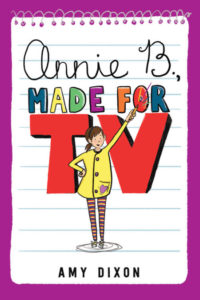craft review by Anne-Marie Strohman
Reviews of Amy Dixon’s Annie B., Made for TV highlight the spot-on, hilarious middle grade voice of Annie Brown’s narration.
“Annie’s first-person narration is hilariously astute.” —Kirkus Review
“On the last day of fifth grade, when her best friend Savannah wins every award, Annie muses, ‘the only thing I’m best at is being the friend of someone who is always the best at everything.’ The engagingly impulsive narrator sells herself short: when it comes to imagination and creative wordplay, Annie has no match.” —Publisher’s Weekly Review

Annie tells the story of the summer she and her best friend Savannah, who is good at everything, go from “almost-always best friends” to maybe-not-friends-at-all. Their friendship hits a crisis when both girls audition to host The Cat’s Meow, a web series for kids produced in their town. Annie struggles through, with the support of her family, to find out what it means to be a friend and to find her own voice.
But no entertaining voice can hold a reader’s attention for the duration of a novel unless there is a compelling plot and the reader is rooting for the main character. Dixon’s first chapter is crafted to make the reader confident in her skill with plot and to put the reader squarely on Annie’s side. Let’s take a look at the first chapter of Annie B., Made for TV to see how the plot and character connection stack up with two different tools: Shawn Coyne’s Five Commandments of Storytelling and Blake Snyder’s Save the Cat.
The Five Commandments of Storytelling
- Inciting Incident
- Progressive Complication
- Crisis
- Climax
- Resolution
These five elements occur on a global scale–the story as a whole–as well as in acts, scenes, and beats. (Coyne uses a 3-act structure: the beginning hook, the middle build, and the ending payoff.)
 Let’s look at how Dixon includes all five elements in Chapter 1.
Let’s look at how Dixon includes all five elements in Chapter 1.
- Inciting Incident: The story opens with a school cheer heralding Jefferson Elementary, the “Home of the Quail.” We find out it’s Annie’s last day of 5th grade, and she’s in the multipurpose room at the beginning of the awards ceremony. The inciting incident of the first chapter is that the Heart of a Quail will be awarded. Annie hopes she might, might, might have a chance at winning.
- Progressive Complications: Dixon introduces Annie’s cheering parents (no pressure there!), and as the awards ceremony goes on, Annie gets only one award, while her best friend Savannah gets tons. Annie is indefatigable–she still hopes she might get the award.
- Crisis: Just as the award is about to be announced, Annie notices a ketchup stain on Savannah’s white shirt. As Savannah tries to rub it out, it gets worse. Annie must choose between helping Savannah and paying attention to the announcement of the Heart of the Quail award.
- Climax: As readers might guess, Savannah wins the award. At that moment, Annie chooses to give her hoodie to cover up Savannah’s stained shirt–she even puts it on her.
- Resolution: Annie stands next to Savannah for pictures, her one reading certificate next to all of Savannah’s awards. The teacher calls her Savannah’s sidekick, and she ends up walking back to her classroom with just her parents.
The chapter introduces something Annie wants, increases the tension with positive expectation (parents) and negative chances (no awards), gives Annie a choice between focusing on what she wants and helping her friend, shows what Annie ultimately decides (in a moment that deals with both the result of Annie’s desire and the emotional conflict of the scene), and finishes with a sense of what this means for Annie from here on out.
By including the five story elements in Chapter 1, Dixon assures readers that the voice of Annie will carry them through a clearly structured story.
Action: Analyze your first chapter to see if it has the five story elements: inciting incident, progressive complications, crisis, climax, and resolution. Use this kind of analysis for your story as a whole, as well as each act, and for scenes that don’t seem to be working. (Coyne covers this material in a few podcasts here.)
Saving the Cat–creating empathy for the main character
The chapter concludes on a low note. It’s disappointing for Annie. But feeling sorry for Annie doesn’t necessarily put us all the way on her side. People do tend to root for the underdog, but only feeling sorry for someone can lead to pity which can too quickly lead to dislike. Blake Snyder, in Save the Cat, argues that your main character must do something early in the story that’s good in order to place the audience squarely on the side of the protagonist. (See examples of Save the Cat moments here. Also see our post on Save the Cat for novelists here, and our Save the Cat analysis posts here and here.)
 He uses the example of Aladdin. On paper, Aladdin is not a great guy. He’s a thief who likes to take risks and thumb his nose at the establishment. He takes from the hardworking merchants. But at the end of the opening song, there’s a quick moment where Aladdin notices two children picking food scraps out of a trash pile. He pauses, looks at the bread he’s stolen, and gives it to the kids. That one gesture makes us like Aladdin–he’s not only out for himself (though he’s definitely out for himself), but he’s also on the side of the little guy.
He uses the example of Aladdin. On paper, Aladdin is not a great guy. He’s a thief who likes to take risks and thumb his nose at the establishment. He takes from the hardworking merchants. But at the end of the opening song, there’s a quick moment where Aladdin notices two children picking food scraps out of a trash pile. He pauses, looks at the bread he’s stolen, and gives it to the kids. That one gesture makes us like Aladdin–he’s not only out for himself (though he’s definitely out for himself), but he’s also on the side of the little guy.
In Annie B., Made for TV, the Save the Cat moment is at the climax of Chapter 1. Annie must decide between paying attention to the award she hopes to get, or helping her friend deal with the ketchup stain. When Savannah wins, Annie goes into high gear to save her friend from embarrassment.
Savannah stays seated, and for a second I can’t figure out why she isn’t popping up like she did for all the other awards. She’s holding her hand over her heart like she’s about to pledge her allegiance. I’m clapping and nudging her, not sure why she isn’t moving, until I see the red peeking out from between her fingers. Oh, right. I quickly unzip my hoodie and hold it out to her. She doesn’t seem to understand at first, so I help her put one arm through and something finally clicks into place. She zips it up over the mess and hugs me before she moves toward the stage. “You’re the best, Annie!”
When it comes to the moment of Savannah’s crisis. Annie doesn’t even have to think. She just helps her friend. Annie’s actions–her “save the cat” moment–convince readers that she is someone to root for.
Action: Make sure you have a “save the cat” moment early in your novel. What about your character makes them likable/redeemable/someone to root for? What particular action shows that characteristic?
Annie’s got a fantastic voice, but by making sure readers sense a clear plot and experience Annie’s “save the cat” moment, Dixon sets up the novel so that readers will keep turning pages. We like Annie, and we trust Dixon’s storytelling. What more could you ask for in a first chapter?
Anne-Marie Strohman (co-editor) writes picture books, middle grade novels, and young adult short stories and novels. She is trained as a teacher, an editor, and a scholar, specializing in Renaissance Literature. She holds an MFA in Writing for Children and Young Adults from Vermont College of Fine Arts and is an active member of SCBWI. Find her at amstrohman.com and on Twitter @amstrwriter.

Great post – so helpful and needed reminder on that important first chapter!